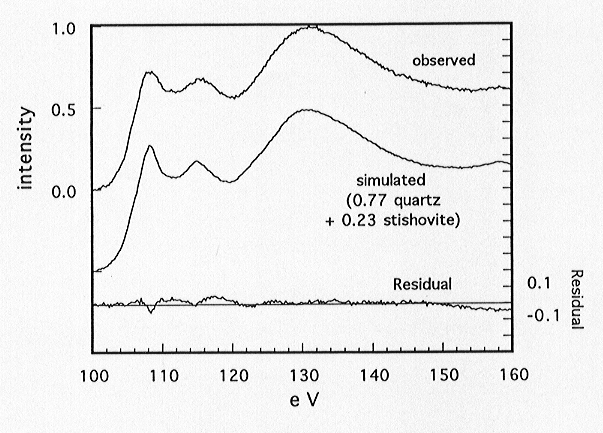

Because the most important features in the Si K- and L-edge ELNES spectra are determined essentially by the Si coordination number to oxygen in the first coordination sphere, this method can be used to determine Si coordination in unknown compounds. A critical test for the validity of this hypothesis is whether the spectra also allow quantitative estimate of proportions of various Si coordinations in a single phase. We have therefore studied Si K- and Si L-edge spectra of the mixed-coordination high-pressure phases majorite garnet Mg3(MgSi)VISiIV3O12, wadeite-type K2SiVISiIV3O9, Na-Mg-Si-pyroxene Na(Mg0.5Si0.5)VISiIV2O6 and compared them to the spectra of low-pressure SiO2 phases quartz and coesite, as well as pyrope Mg3Al2Si3O12 and jadeite NaAlSi2O6, that have Si in tetrahedral coordination only.
As a first test, we have calculated by multiple scattering techniques the theoretical contributions of the SiIV and SiVI species to the total spectrum and confirmed that, even in a complex structure, the contributions of these different sites are similar to those of single SiO4 and SiO6 clusters, respectively.
The ELNES spectra of the mixed-coordination high-pressure phases do
not resemble those of either quartz or stishovite. Rather, in terms of
positions of peaks, their intensities and half widths the spectra are generally
intermediate between those having Si exclusively in tetrahedral or octahedral
coordination. Thus, we have simply approximated the spectra as a weighted
sum of a tetrahedral Si reference spectrum (e.g. that of quartz) and an
octahedral Si spectrum (e.g. stishovite), and minimized the difference
by changing the relative proportions of the SiIV and SiVI
reference spectra. The optimum fit then gives the proportions of SiIV
and SiVI in the spectrum investigated. Although the uncertainties
in this procedure are large (e.g. because of uncertainties in the energy
calibrations, intrinsic shifts of the edge energy as a function of structure
type, effects of plural scattering and sloping backgrounds), these determinations
are found to be semiquantitative (with an uncertainty of the order of 0.15
in SiIV/(SiIV + SiVI) ratio). Fig. 3.3-7
gives an example for the wadeite-type K2Si4O9
compound, where SiIV/(SiIV + SiVI) = 0.77
is derived in this manner from the Si L-edge spectra. This value is very
close to the nominal value of 0.75. Work on the Si K-edge and and the other
mixed-coordination compounds is in progress.
 |
Fig. 3.3-7: Comparison of observed Si L-edge ELNES spectrum of wadeite-type K2Si4O9 (top) to a weighted sum of the Si L-edge spectra of quartz and stishovite (centre). |

Tel: +49-(0) 921 55 3700 / 3766, Fax: +49-(0) 921 55 3769, E-mail: bayerisches.geoinstitut(at)uni-bayreuth.de
 Previous page
Previous page